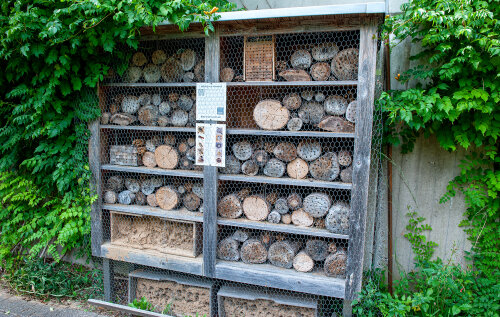by Christopher Bause from the team of PD Dr. Thomas Eltz (Chair of Evolutionary Ecology & Biodiversity of Animals, Prof. Dr. Ralph Tollrian)
There are almost 600 species of wild bees in Germany. In contrast to honey bees, the vast majority of wild bees do not live together in large colonies, but as solitary individuals. Many wild bee species prefer to colonise dry, warm and open landscapes. Wild bees place high demands on their habitats. They need diverse landscapes with hedges, dead wood, open areas of bare ground and, of course, plenty of wildflowers.


Unfortunately, wild bees have a very difficult time nowadays in our cultural landscape, dominated by industry and agriculture. There is usually a lack of suitable nesting sites or materials and the variety of suitable forage plants is also very limited. However, some species of wild bees also feel quite at home in urban areas. Stille, even here, species-poor, gravelled front gardens and exclusively green parks without wildflowers do not make life easier for wild bees.



Here in the Botanical Garden of the Ruhr University Bochum there is still a variety of habitats and, of course, a large variety of wildflowers. Wild bees find many nesting opportunities here, such as dry stone walls, dead wood and more or less open, sandy patches of soil. In the specially provided wild bee "hotel" in our medicinal garden, there are also hollow plant stems, wood with boreholes and a simulated cliff face made of loam.
Photo left: Our wild bee hotel in the medicinal garden - © RUB / Wolfgang Stuppy

As far as their food is concerned, wild bees are often very specialised and only collect pollen from a certain group of plants to feed their offspring. With pollen from other plants the next generation could not develop. Wild bees species that are highly specialised in certain plant species are called 'oligolectic'. They only occur where they can find their pollen plants. If the right plant is missing, then the corresponding bee is also absent.
Photo right: Die small sallow mining bee (Andrena praecox) is specialised on willow pollen (Salix spp., Salicaceae) which it collects on its hind legs - © RUB / Christopher Bause

Unlike wild bees, honey bees are 'polylectic', which means that they collect pollen and nectar from a variety of different plant species. They are therefore more adaptable and also cope very well with non-native plants in gardens and parks. There are also numerous species of wild bees that are not very picky when it comes to their food plants - bumblebees!
Photo left: honey bees (Apis mellifera) are not very picky and collect pollen and nectar from many different plants, here from winter heath (Erica carnea, Ericaceae) - © RUB / Christopher Bause
(click on the picture to enlarge!)